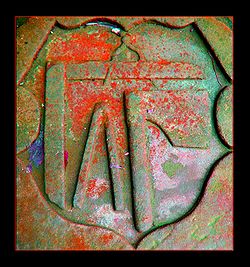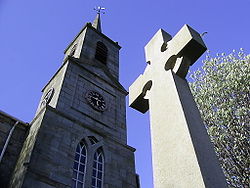
Scottish gravestones
Encyclopedia

British Isles
The British Isles are a group of islands off the northwest coast of continental Europe that include the islands of Great Britain and Ireland and over six thousand smaller isles. There are two sovereign states located on the islands: the United Kingdom of Great Britain and Northern Ireland and...
. The study of Scottish Lowland
Scottish Lowlands
The Scottish Lowlands is a name given to the Southern half of Scotland.The area is called a' Ghalldachd in Scottish Gaelic, and the Lawlands ....
Gravestones is essential to the overall study of British monumental inscription
Monumental inscription
A monumental inscription is an inscription, typically carved in stone, on a grave marker, cenotaph, memorial plaque, church monument or other memorial....
s. The level of symbolism and detail on Scottish stones reached a peak during the 18th century.
Early tombs
The earliest tombs in Scotland are now lost. If Palaeolithic man ever set foot in that country, all traces have been wiped away. However, numerous MesolithicMesolithic
The Mesolithic is an archaeological concept used to refer to certain groups of archaeological cultures defined as falling between the Paleolithic and the Neolithic....
and Neolithic
Neolithic
The Neolithic Age, Era, or Period, or New Stone Age, was a period in the development of human technology, beginning about 9500 BC in some parts of the Middle East, and later in other parts of the world. It is traditionally considered as the last part of the Stone Age...
tombs, cairn
Cairn
Cairn is a term used mainly in the English-speaking world for a man-made pile of stones. It comes from the or . Cairns are found all over the world in uplands, on moorland, on mountaintops, near waterways and on sea cliffs, and also in barren desert and tundra areas...
s, chambered cairns and burial mounds have been discovered and studied. The Bronze
Bronze Age
The Bronze Age is a period characterized by the use of copper and its alloy bronze as the chief hard materials in the manufacture of some implements and weapons. Chronologically, it stands between the Stone Age and Iron Age...
and Iron Age
Iron Age
The Iron Age is the archaeological period generally occurring after the Bronze Age, marked by the prevalent use of iron. The early period of the age is characterized by the widespread use of iron or steel. The adoption of such material coincided with other changes in society, including differing...
s may have pioneered the concept of a modern graveyard
Graveyard
A graveyard is any place set aside for long-term burial of the dead, with or without monuments such as headstones...
for their remains have been found grouped together in much the same manner as today. In addition to using traditional burial methods, they would also create allotments for their dead. Iron Age burials are, however currently rare in Britain.
Early church burials

Saxons
The Saxons were a confederation of Germanic tribes originating on the North German plain. The Saxons earliest known area of settlement is Northern Albingia, an area approximately that of modern Holstein...
, Normans
Normans
The Normans were the people who gave their name to Normandy, a region in northern France. They were descended from Norse Viking conquerors of the territory and the native population of Frankish and Gallo-Roman stock...
and Flemish
County of Flanders
The County of Flanders was one of the territories constituting the Low Countries. The county existed from 862 to 1795. It was one of the original secular fiefs of France and for centuries was one of the most affluent regions in Europe....
knights were given lands throughout Scotland
Scotland
Scotland is a country that is part of the United Kingdom. Occupying the northern third of the island of Great Britain, it shares a border with England to the south and is bounded by the North Sea to the east, the Atlantic Ocean to the north and west, and the North Channel and Irish Sea to the...
. The new lords built chapels and churches on their new estates. With so many servants, beneficiaries and eventually Tenants, the Church land was soon used to bury the dead of the surrounding village.
Pre-Reformation

Scottish Reformation
The Scottish Reformation was Scotland's formal break with the Papacy in 1560, and the events surrounding this. It was part of the wider European Protestant Reformation; and in Scotland's case culminated ecclesiastically in the re-establishment of the church along Reformed lines, and politically in...
stones exist today and those that do are often removed from their original position and given care and shelter in a local museum. Medieval stone coffins, or sarcophagi, are more abundant.
Since 1457, it had been the habit to organise the local Wappenshaw (presenting weapon
Weapon
A weapon, arm, or armament is a tool or instrument used with the aim of causing damage or harm to living beings or artificial structures or systems...
ry for inspection) in the local graveyards. The resulting wounds on the fine sandstone of many rare stones has left them defaced by the continuous bombardment of missiles.
Post-Reformation
The 16th century, the century in which Scotland played host to her own Protestant ReformationProtestant Reformation
The Protestant Reformation was a 16th-century split within Western Christianity initiated by Martin Luther, John Calvin and other early Protestants. The efforts of the self-described "reformers", who objected to the doctrines, rituals and ecclesiastical structure of the Roman Catholic Church, led...
, was a quiet one for Scottish gravestones. It seems that they were seldom produced and are indeed a rare sight today in our old graveyards. More stones were produced in the 17th and 18th centuries.
17th-century stones

Death
Death is the permanent termination of the biological functions that sustain a living organism. Phenomena which commonly bring about death include old age, predation, malnutrition, disease, and accidents or trauma resulting in terminal injury....
and the name, date of birth and often the address of the deceased began to be crammed onto the limited surfaces of the stone.
One side of the headstone was dedicated to written identification while the other was to be used for symbolic expression. The symbolic elements would usually reveal the man's occupation while reminding the living viewer that he or she too must depart this earth sooner or later.
18th-century stones

18th-century Scottish gravestones are almost always oriented east to west. The part which contains the identification of the cadaver usually faces towards the Holy Land
Holy Land
The Holy Land is a term which in Judaism refers to the Kingdom of Israel as defined in the Tanakh. For Jews, the Land's identifiction of being Holy is defined in Judaism by its differentiation from other lands by virtue of the practice of Judaism often possible only in the Land of Israel...
. Since most 18th-century were left relatively unadorned, the rear side of stone was frequently left unmarked. This is the side that invariably faced away from the Holy Land, towards the west. However, in many lowland graveyards, the side usually left unmarked is covered with extravagant designs.

19th-century stones
The 19th century saw almost all memorial permutations of the past come back with gusto. Wall monuments, crypts, headstones, table and slab stones and even replica Hog Backs were all common designs in Victorian Scotland. The introduction of the Cast-Iron Grave Marker would simply add yet another embellishment to an already decorative art form.External links
- ScottishGraveyards.Org
- Historic Scotland on Gravestones and Graveyards
- Monumental Images
- Scotfot, Scottish gravestone images
See also
- CemeteryCemeteryA cemetery is a place in which dead bodies and cremated remains are buried. The term "cemetery" implies that the land is specifically designated as a burying ground. Cemeteries in the Western world are where the final ceremonies of death are observed...
- GraveyardGraveyardA graveyard is any place set aside for long-term burial of the dead, with or without monuments such as headstones...
- ChurchyardChurchyardA churchyard is a patch of land adjoining or surrounding a church which is usually owned by the relevant church or local parish itself. In the Scots language or Northern English language this can also be known as a kirkyard or kirkyaird....
- HeadstoneHeadstoneA headstone, tombstone, or gravestone is a marker, usually stone, that is placed over a grave. In most cases they have the deceased's name, date of birth, and date of death inscribed on them, along with a personal message, or prayer.- Use :...
- DreghornDreghornDreghorn is a village near Irvine, North Ayrshire, Scotland. This parish comprehends the old parishes of Dreghorn and Pearston, which were united in 1668. The whole of the parish was historically the property of the De Morvilles, who were Constables of Scotland and Lords of Cunninghame...
- PercetonPercetonPerceton is a medieval settlement and estate in North Ayrshire, Scotland, near the town of Irvine. The old church in Perceton is one of the oldest buildings in the Irvine district...
Sources
- Understanding Scottish Graveyards by B. Willsher
- Scottish Epitaphs by B. Willsher
- History of the Royal Burgh of Irvine by John Strawhorn
- A Historical Guide to Ayrshire by Dane Love
- Stones: a guide to some remarkable eighteenth-century gravestones by Betty Willsher and Doreen Hunter. Edinburgh : Canongate, 1978.
- East Lothian gravestones by Islay Donaldson. East Lothian District Council, 1991.
- Midlothian gravestones by Islay Donaldson. Midlothian District Library Service, 1994.

